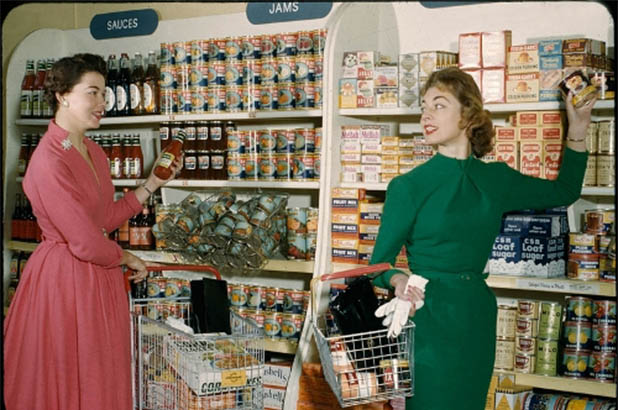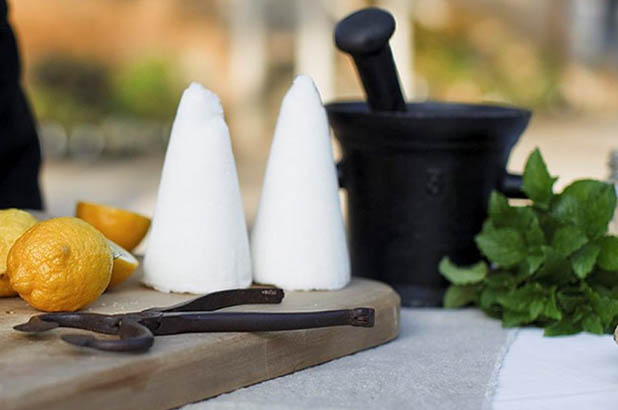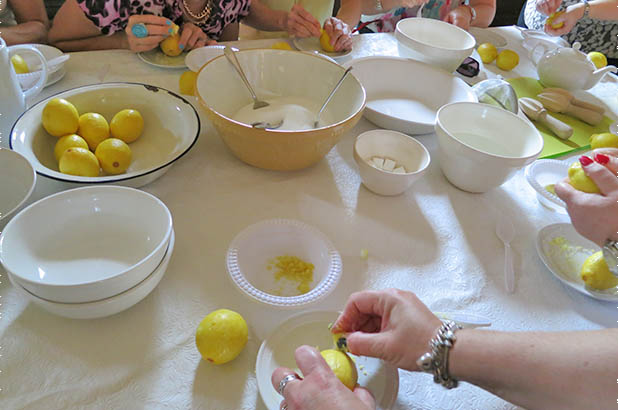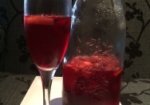While the Curator has been pulling punches, colonial style, I’ve been busy with the more delicate art of cordial making. Participants at our two Colonial gastronomy: punches, cordials and refreshers workshops got to sample several traditional beverages: the homemade Vaucluse House-grown elderflower cordial, a ginger beer, a raspberry vinegar cordial – which was a special treat for children in the 19th century – and also made their own lemon ‘sherbet’ following a recipe from 1816.
The ‘raspberry vinegar refresher’ was probably the biggest surprise – a vastly different and more sophisticated taste than the ‘pink lemonade’ we have now. It’s very easy to make, even with frozen raspberries, and, although it is sweetened, the acid note from the vinegar complements the naturally tart taste of raspberries picked straight from the bush on a warm day. I like mixing it with soda for sparkle, and it is quite an elegant drink served in a champagne flute at parties on those occasions when you have to drive or need a clear head the next day.
Raspberry vinegar cordial ‘shrub’
Ingredients
- 300g fresh or frozen raspberries
- 500ml (2 cups) good-quality white wine vinegar
- 200g white granulated sugar
Note
Mix a splash of this cordial concentrate with mineral water for a summer refresher, or use as a base for a 'shrub' drink or fruit punch, adding slices of apple, orange and fresh berries.
The acidity diminishes over time, so make and store the cordial for several weeks before using.
Directions
| Steep the raspberries in the vinegar in a non-metallic bowl or jug for several days. | |
| Strain the mixture through a muslin-lined sieve, and allow to drain for an hour or so, taking care not to apply pressure to the fruit. | |
| Discard the fruit and transfer the liquid to a small saucepan. Add the sugar and stir gently over low heat for 10 minutes or until the sugar dissolves. Skim or strain the liquid through a fine sieve and allow to cool. | |
| Pour the cordial into a sterilised airtight bottle or jar and store in a cool, dark place for up to 12 months. | |
| Add 1 or 2 tablespoons to a glass of iced water or soda and garnish with mint. Very refreshing! | |
A raspingly good time
A ‘raspingly’ good time was had on Sunday 24 February at Elizabeth Farm, when 15 would-be kitchen hands made their own bottle of lemon sherbet from an 1816 recipe.
The difference between lemon sherbet and what we’d call ‘old-fashioned’ lemonade is the technique of ‘rasping’ the aromatic oils from the lemon skin before juicing the fruit.
This all-but-lost art was common and very practical when sugar came in ‘loaf’ form. The loaves were formed into a conical shape (see image at top) while the refined sugar was still moist, which then set quite hard. Sugar nips, which look like a cross between tongs and scissors, were used to cut off chunks of sugar, to be either pounded in a mortar and pestle into the familiar granules we now purchase as ‘sugar’ or left whole for the purpose of rasping.
Fortunately we can still rasp a lemon using bought sugar cubes – simply rub the skin with the edges of a cube and it will absorb the flavour and colour from the skin. See recipe below – delicious!
Rasped lemon sherbet
Ingredients
- 8 sugar cubes
- 2 rough-skinned lemons
- 2 tablespoons white granulated sugar
- 2 tablespoons boiling water
Note
Adapted from Maria Rundell's A new system of domestic cookery (1816).
Rasping is a technique that has almost become lost, as sugar is now commonly available in granulated rather than in 'loaf', or compressed, form. We can achieve the same result by simply using bought sugar cubes. Rub the skin of the lemon with sugar cubes until the colour leaves the skin, but note – store-bought lemons often have a wax coating, so rinse them in boiling water first to remove the excess wax. Choose rough-skinned lemons, as it is harder to rasp away smooth skin. The natural acidity in lemons is variable, so the amount of sugar used in this recipe is a guide only.
Makes 150 ml
Directions
| Working on a plate to catch the 'raspings', rub the sugar cubes over the lemons, using consistent pressure so the sugar absorbs the lemon flavour and colour. As each cube crumbles, continue with another cube. Scrape the lemony sugar raspings into a small bowl, keeping the skinned lemons aside. Add the white granulated sugar to the raspings with the boiling water and stir until all the sugar dissolves. Squeeze the juice from the lemons and stir it into the mixture, then strain the mixture through a fine sieve. Pour the resulting 'sherbet' into a sterilised airtight bottle or jar. It can be kept in the fridge until required. Mix a tablespoon or two with water or soda water for a rich and refreshing lemonade. | |
One lump or two?
This greeting card (below) from the State Library of NSW caught my eye not so long ago. Look at the blue and white CSR boxes on the shelf to the right of the customer dressed in green. This 1950s image indicates that the term ‘loaf’ was still being used in Australia in our more recent history, referring to what the Americans call ‘lump sugar’ and we know today as ‘sugar cubes’.

Interior of Broadhead & Barcham self service grocery store, Sydney, c1957. Photo Jack Hickson © Australian Photographic Agency. Mitchell Library, State Library of NSW: ON 173
Landmark loaves
Pioneers and explorers often named natural geological formations ‘sugarloaf mountains’, with the reference now lost on modern generations. The most famous is in Rio de Janeiro; however, our very own W C Wentworth of Vaucluse House, has his own ‘sugarloaf mountain’ – as does fellow explorer Lawson – on the Lithgow side of the Blue Mountains: hills named after them to mark their successful crossing to ‘the other side’ 200 years ago in 1813. (NB: There are also more than 270 mountains and hills in Australia and many more around the world named with a variant of sugarloaf!)

 Print recipe
Print recipe


